Cards In This Set
| Front | Back |
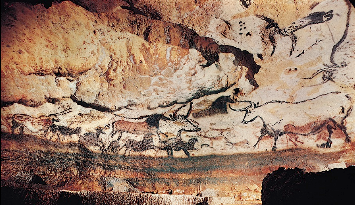 Picture |
Hall of Bulls, Lascaux Cave, Montignac, France, c. 18000-10000 BC Caves made of limestone and have been very deep within mountains, not readily accessible - Does this imply that they are very special and used for ritual?From the Paleolithic period, the oldest stone agePaint is a mixture of animal fat and vegetable juices and sometimes blood and waterAll cave paintings are a pictograph which means it's showing what's represented, that you can recognize it as an animal – used in modern day street signs
|
|
Ideograph
|
Have to know the context of the symbol in order to understand (the longhorn sign standing for the annual cattle run in the stockyards)
|
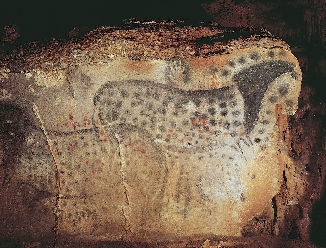 Picture |
Horses and Hands, Pech-Merle Cave,
France, 23000-18000 BC
-shows spotted horses and handprints - the handprints serve as putting your mark on something -paint has been blown through a bone to create the stencil quality of the hands |
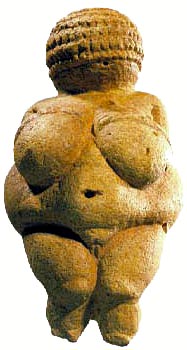 Picture |
Statuette of a Woman (Venus of
Willendorf), Austria, 22000-20000 BC
-it's linked to some fertility ritual or notion because of the exxagerated features -it's 4 inches in height and is a handheld object -there is a reddish coloration because it was painted and the back is not as finished as the front, so the back was held in a hand |
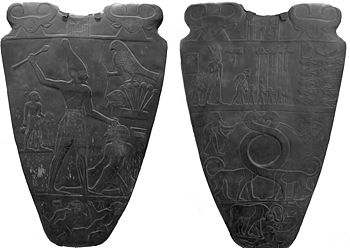 Picture |
Narmer Palette, Egypt, 3200-3000 BC-we know man is of authority because of his tall stature, crown and scale. His chest is also facing front, where the other men are all in profile view. The other men are inferior because they are smaller in scale and are bent over
-there are three parts or divisions, with the largest given to the pharaoh -it is Egyptian -the people on the bottom are either running away or floating away and they are most likely dead -the falcon (a god) is associated with the king and is holding on to a human headed form with papyrus which represents the lower part of Egypt -the small man next to the large man has a shelf and is holding the pharoah's shoes. His shoes being off shows his holiness and that he is on sacred ground -he's wearing a crown of upper Egypt. The cattle represent another goddess who is the guardian of the pharoah. In between the cattle is a hieroglyphic form of the sacred writing of the egyptians . -So the picture is of Narmer conquering lower Egypt Version:1.0 StartHTML:0000000167 EndHTML:0000000649 StartFragment:0000000457 EndFragment:0000000633 -it's the celebration of Narmer who has claimed his right to rule and who has united Egypt -considered a bas relief, is about 18 inches long |
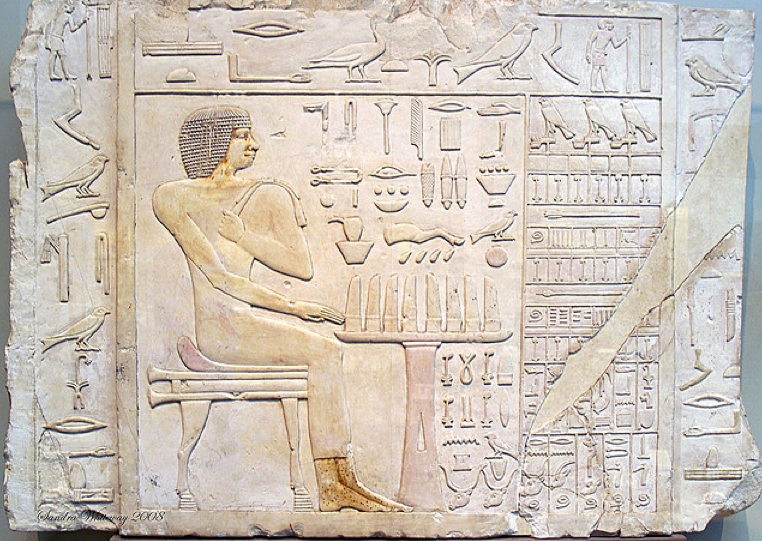 Picture |
Hieroglyphics on relief from tomb of
Rehotep, Egypt, 2600 BC
-the afterlife was very important for Egyptians so the tombs held images that ensured their journey to a successful afterlife. -hieroglyphics means “sacred carving” were written with a reed brush on papyrus -it begins as a picture writing system, it's a series of pictographs. Over time it will change -pictographs -------- logographs (an image standing for a word) ---------- phonograms (sounds) -hieratic was more an abstract element that scribes used, used for religious writings -the demotic was used for secular: inventories, laws, everyday things |
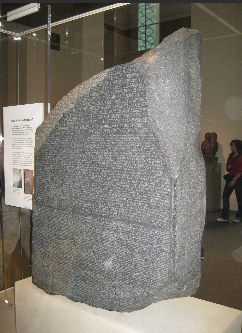 PIcture |
Rosetta Stone, Egypt, 196 BC
-stele, commemorative stone were often freestanding and in a public area -it was the key to understanding hieroglyphics -It includes carved hieroglyphics as well as the demotic script and greek, that's how they were able to translate it |
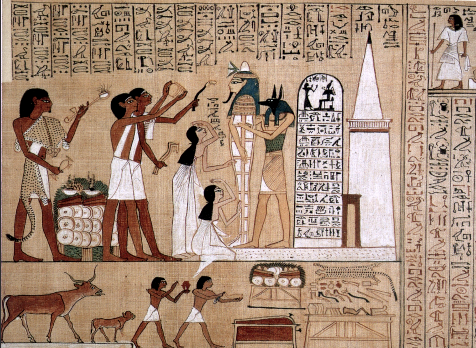 Picture |
Book of the Dead, Egypt, 1310
BC
-written on papyrus which is found by the nile river, were laid vertically side by side and then horizontal on top. It was pieced together so you could create a scroll. Thought this book helped prepare them to go into the afterlife, so it would be put in tombs -the egyptians were the first to produce illustrated manuscripts (means “hand written”) where words and pictures are combined to convey information |
 Picture |
Hammurabi's Code, Babylon, 1780
BC
-Middle east civilizations made many contributions like farming, irrigation, use of bronze– Persian, Assyrians, Sumerians, etc -A carved stone with the babylonian ruler who is presenting the law of the land. The laws are dealing with the wealthy and unwealthy, the punishments for the wealthy people are more severe -the sun god is in the seat of authority, holding the rod of authority and with iconic headdress -hammurabi has received the law from the diety, and he is without shoes being on sacred ground |
|
Stele
|
A vertically oriented chunk of rock
that is inscribed and has a public character (a mileage marker).
However, very few people of this time could read.
|
|
Cuneiform
|
Form of picture writing, developed
around 3400 BC, initially on clay tablets
means 'wedged-shape' marks are created with a triangular tipped stylus that is impressed into the clay. It's a written form that various languages could use, it's not an alphabet |
|
Picture
|
Trajan's Column, Rome 144
-the Romans copied and admired the Greeks and used their ideas including the alphabet, but they changed the letterforms with serifs -is a celebratory monument commemoration trajan's military victory, has a continuous narrative that goes up the column, like a winding scroll, it's 12 stories tall -majuscules – means capital letters -the tradition is still kept, Nick Benson uses same letterforms to carve on monuments |
|
PIcture
|
Licinia Amis Tombstone, 280 and
Tombstone with scene of baptism, 400
-christian tombstone. Christians were outlawed and met in the catacombs -Constantine legalized christianity as a religion, it becomes official religion -Christians, initially, used the letterforms of the pagan Romans |
|
Advantages of the codex (book) over the
scroll
|
-hard exterior offers protection to the
inside interior instead of pages being curled around
themselves
-accessibility is easier – to find what you need to read, had a table of contents instead of unrolling a 17 foot scroll. Easier to find the title on the spine -books are more compact, easier to store. Scrolls are not always gonna be the same size -more durable for transportation, can get to more people -parchment is quicker and more economical to produce than papyrus |
|
Medieval Illuminated Manuscripts
|
-5th century to the 15th
century
-period that includes art of the monasteries in northern england -spreading the Christian word through books that are in the hands of the wealthy or in church -all is on parchment on or vellum which is a higher quality parchment, all is hand-done -By 4th century, Latin was the language of the church and text had to be translated from Greek or Hebrew to Latin, and the church keeps latin going as an international language |



